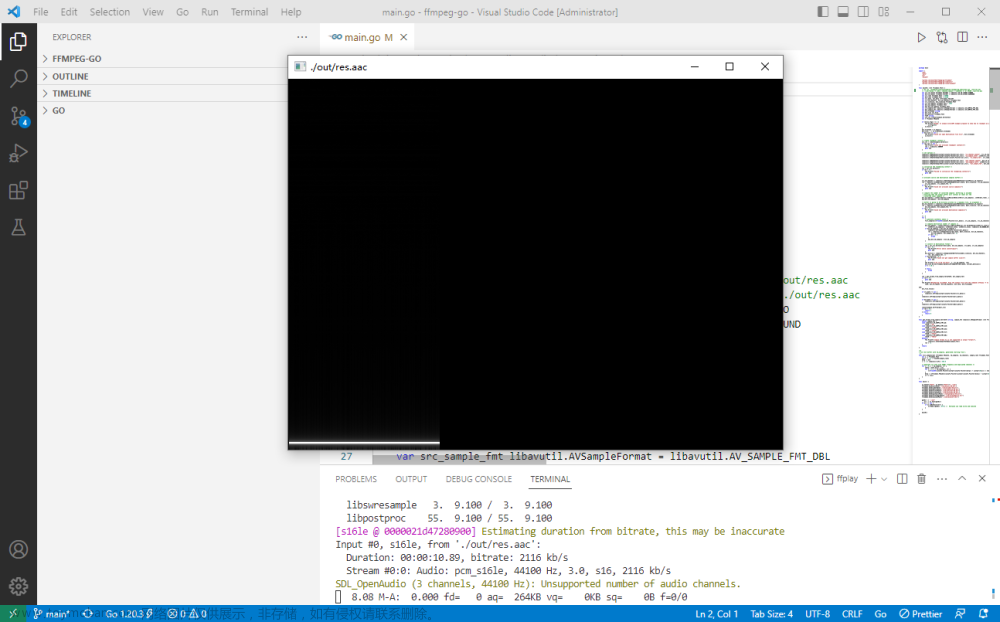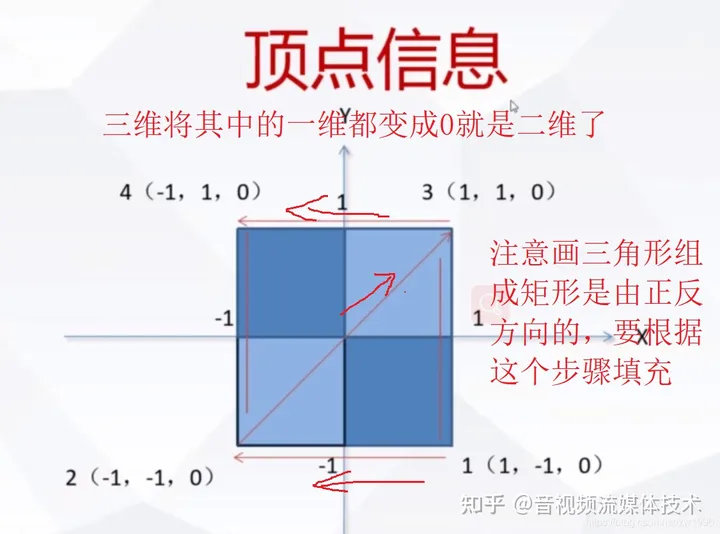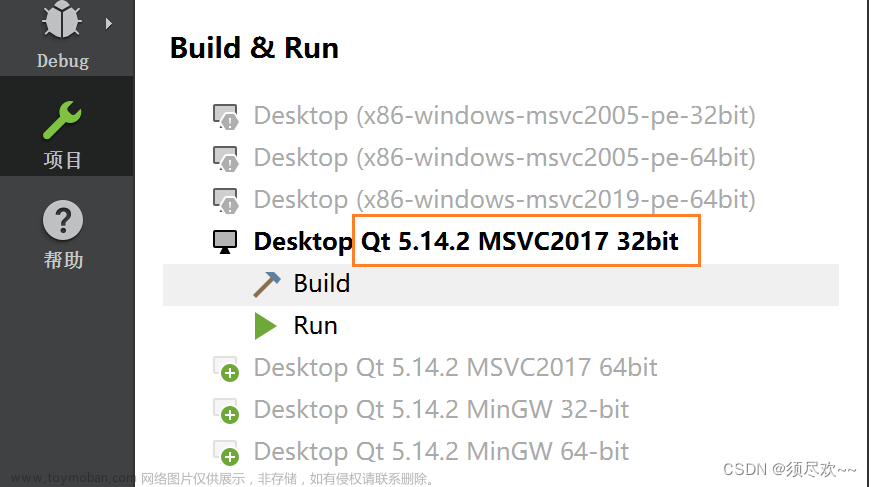需求:
将一首歌mp3格式,和一段无声音录屏mp4格式,合成到一起,使播放视频时能听到这首歌。
实现原理:
打开mp3音频,解析出输入音频流,再打开mp4视频,解析出输入视频流。
然后打开输出环境,创建2个输出流,分别对应音频输入流和视频输入流。
最后循环交替从音频流和视频流读取AVPacket,依次写入输出环境。
使用ffmpeg命令实现音视频混合很简单:
ffmpeg -i xxx1.mp3 -i xxx2.mp4 out.mp4
要点:
1 AVPacket::stream_index
将AVPacket写入输出环境时,音频和视频的stream_index不能相等,如果音频的stream_index等于0,那么视频的stream_index需要等于1,可以手动改。出现这种情况的原因是输入的xxx1.mp3可能包含2个流,一个是音频,另一个是视频,音频流索引是0,视频流索引是1。这里的视频实际上是播放音乐时显示的一张图片。输入的xxx2.mp4至少包含2个流,一个是音频,另一个是视频,而这里视频流索引是0,音频流索引是1。画个图:
xxx1.mp3
- stream0(audio)
- stream1(video)
xxx2.mp4
- stream0(video)
- stream1(audio)
出现这种情况,从xxx1.mp3解析出来的AVPacket和xxx2.mp4解析出来的AVPacket的stream_index都为0,如果不改直接写到输出环境,ffmpeg就会报错。
2 void av_packet_rescale_ts(AVPacket *pkt, AVRational tb_src, AVRational tb_dst);
* Convert valid timing fields (timestamps / durations) in a packet from one
* timebase to another. Timestamps with unknown values (AV_NOPTS_VALUE) will be
* ignored.
将从输入流解析出的AVPacket的跟时间相关字段,从当前的输入流时基对应的值转为输出流时基对应的值。音频和视频都是用这个函数。这样合成后的音频和视频就能有序播放。
3 别犯低级错误,比如成员变量pkg与pkg2混淆导致出问题。
附上调试学习研究用的代码
文件名xxx.c(cpp会编不过)
包含目录,ffmpeg头文件所在的目录
C:\work\env\msys2\usr\local\include;
包含库目录,ffmpeg静态库所在的目录
C:\work\env\msys2\usr\local\lib;
依赖的静态库
libavcodec.a
libavdevice.a
libavfilter.a
libavformat.a
libavutil.a
libswresample.a
libswscale.a
SDL2.lib
SDL2main.lib
mfuuid.lib
ole32.lib
strmiids.lib
user32.lib
psapi.lib
uuid.lib
oleaut32.lib
shlwapi.lib
gdi32.lib
vfw32.lib
secur32.lib
ws2_32.lib文章来源:https://www.toymoban.com/news/detail-629293.html
bcrypt.lib文章来源地址https://www.toymoban.com/news/detail-629293.html
// 需求:将一首歌mp3格式,和一段无声音录屏mp4格式,合成到一起,使播放视频时能听到这首歌。
//#include <file.h>
#include "libavformat/avformat.h"
#include "libavutil/dict.h"
#include "libavutil/opt.h"
#include "libavutil/timestamp.h"
#include "libswscale/swscale.h"
#include "libswresample/swresample.h"
#include "libavutil/imgutils.h"
#include "libavcodec/avcodec.h"
static void log_packet(const AVFormatContext* fmt_ctx, const AVPacket* pkt, const char* tag)
{
AVRational* time_base = &fmt_ctx->streams[pkt->stream_index]->time_base;
printf("%s: pts:%s pts_time:%s dts:%s dts_time:%s duration:%s duration_time:%s stream_index:%d\n",
tag,
av_ts2str(pkt->pts), av_ts2timestr(pkt->pts, time_base),
av_ts2str(pkt->dts), av_ts2timestr(pkt->dts, time_base),
av_ts2str(pkt->duration), av_ts2timestr(pkt->duration, time_base),
pkt->stream_index);
}
int main()
{
int ret = 0;
// 打开音频流
avformat_network_init();
AVFormatContext* ifmt_ctx = NULL;
const char* inputUrl = "jietuo.mp3";
ret = avformat_open_input(&ifmt_ctx, inputUrl, NULL, NULL);
if (ret != 0)
{
printf("Couldn't open input stream.\n");
return -1;
}
if (avformat_find_stream_info(ifmt_ctx, NULL) < 0)
{
printf("Couldn't find stream information.\n");
return -1;
}
av_dump_format(ifmt_ctx, 0, inputUrl, 0);
int audio_index = av_find_best_stream(ifmt_ctx, AVMEDIA_TYPE_AUDIO, -1, -1, NULL, 0);
AVStream* st = ifmt_ctx->streams[audio_index];
const AVCodec* codec = NULL;
codec = avcodec_find_decoder(st->codecpar->codec_id);
if (!codec)
{
fprintf(stderr, "Codec not found\n");
exit(1);
}
AVCodecContext* codec_ctx = NULL;
codec_ctx = avcodec_alloc_context3(codec);
if (!codec_ctx)
{
exit(1);
}
avcodec_parameters_to_context(codec_ctx, ifmt_ctx->streams[audio_index]->codecpar);
if ((ret = avcodec_open2(codec_ctx, codec, NULL) < 0))
{
return -1;
}
AVPacket* pkt = av_packet_alloc();
// 打开视频流
AVFormatContext* ifmt_ctx2 = NULL;
const char* inputUrl2 = "luping.mp4";
ret = avformat_open_input(&ifmt_ctx2, inputUrl2, NULL, NULL);
if (ret != 0)
{
printf("Couldn't open input stream %s.\n", inputUrl2);
return -1;
}
if (avformat_find_stream_info(ifmt_ctx2, NULL) < 0)
{
printf("Couldn't find stream information.\n");
return -1;
}
av_dump_format(ifmt_ctx2, 0, inputUrl2, 0);
int video_index = av_find_best_stream(ifmt_ctx2, AVMEDIA_TYPE_VIDEO, -1, -1, NULL, 0);
AVStream* st2 = ifmt_ctx2->streams[video_index];
const AVCodec* codec2 = NULL;
codec2 = avcodec_find_decoder(st2->codecpar->codec_id);
if (!codec2)
{
fprintf(stderr, "Codec not found\n");
exit(1);
}
AVCodecContext* codec_ctx2 = NULL;
codec_ctx2 = avcodec_alloc_context3(codec2);
if (!codec_ctx2)
{
exit(1);
}
avcodec_parameters_to_context(codec_ctx2, ifmt_ctx2->streams[video_index]->codecpar);
if ((ret = avcodec_open2(codec_ctx2, codec2, NULL) < 0))
{
return -1;
}
AVPacket* pkt2 = av_packet_alloc();
// 打开输出流
const char* outputUrl = "out.mp4";
AVFormatContext* ofmt_ctx = NULL;
avformat_alloc_output_context2(&ofmt_ctx, NULL, "mpegts", outputUrl);
if (!ofmt_ctx) {
printf("Could not create output context\n");
return -1;
}
const AVOutputFormat* ofmt = ofmt_ctx->oformat;
{
//创建输出音频流
AVStream* out = avformat_new_stream(ofmt_ctx, NULL);
if (!out)
{
return -1;
}
//复制配置信息
AVCodecParameters* codecpar = ifmt_ctx->streams[audio_index]->codecpar;
avcodec_parameters_copy(out->codecpar, codecpar);
out->codecpar->codec_tag = 0;
}
{
//创建输出视频流
AVStream* out = avformat_new_stream(ofmt_ctx, NULL);
if (!out)
{
return -1;
}
//复制配置信息
AVCodecParameters* codecpar = ifmt_ctx2->streams[video_index]->codecpar;
avcodec_parameters_copy(out->codecpar, codecpar);
out->codecpar->codec_tag = 0;
}
av_dump_format(ofmt_ctx, 0, outputUrl, 1);
//Open output URL
if (!(ofmt->flags & AVFMT_NOFILE)) {
ret = avio_open(&ofmt_ctx->pb, outputUrl, AVIO_FLAG_WRITE);
if (ret < 0) {
printf("Could not open output URL '%s'", outputUrl);
return -1;
}
}
//Write file header
ret = avformat_write_header(ofmt_ctx, NULL);
if (ret < 0) {
printf("Error occurred when opening output URL\n");
return -1;
}
int duration_audio = 0;
int duration_video = 0;
// 音视频合成
while (1)
{
//if (duration_audio < duration_video)
{
AVStream* in_stream, * out_stream;
ret = av_read_frame(ifmt_ctx, pkt);
if (ret < 0)
break;
if (pkt->stream_index == audio_index)
{
in_stream = ifmt_ctx->streams[pkt->stream_index];
out_stream = ofmt_ctx->streams[0];
log_packet(ifmt_ctx, pkt, "in");
/* copy packet */
av_packet_rescale_ts(pkt, in_stream->time_base, out_stream->time_base);
pkt->pos = -1;
log_packet(ofmt_ctx, pkt, "out");
duration_audio += pkt->duration;
ret = av_interleaved_write_frame(ofmt_ctx, pkt);
/* pkt is now blank (av_interleaved_write_frame() takes ownership of
* its contents and resets pkt), so that no unreferencing is necessary.
* This would be different if one used av_write_frame(). */
if (ret < 0) {
fprintf(stderr, "Error muxing packet\n");
break;
}
}
else
{
av_packet_unref(pkt);
}
}
//else
{
AVStream* in_stream, * out_stream;
ret = av_read_frame(ifmt_ctx2, pkt2);
if (ret < 0)
break;
if (pkt2->stream_index == video_index)
{
in_stream = ifmt_ctx2->streams[pkt2->stream_index];
pkt2->stream_index = 1;
out_stream = ofmt_ctx->streams[1];
log_packet(ifmt_ctx2, pkt2, "in");
/* copy packet */
av_packet_rescale_ts(pkt2, in_stream->time_base, out_stream->time_base);
pkt2->pos = -1;
log_packet(ofmt_ctx, pkt2, "out");
duration_video += pkt2->duration;
ret = av_interleaved_write_frame(ofmt_ctx, pkt2);
/* pkt is now blank (av_interleaved_write_frame() takes ownership of
* its contents and resets pkt), so that no unreferencing is necessary.
* This would be different if one used av_write_frame(). */
if (ret < 0) {
fprintf(stderr, "Error muxing packet\n");
break;
}
}
else
{
av_packet_unref(pkt2);
}
}
/*if (av_read_frame(ifmt_ctx2, pkt2) >= 0)
{
if (pkt2->stream_index == video_index)
{
int video = av_find_best_stream(ofmt_ctx, AVMEDIA_TYPE_VIDEO, -1, -1, NULL, 0);
av_packet_rescale_ts(pkt2, st2->time_base, ofmt_ctx->streams[video]->time_base);
av_interleaved_write_frame(ofmt_ctx, pkt2);
}
}
else
{
break;
}
if (av_read_frame(ifmt_ctx, pkt) >= 0)
{
if (pkt->stream_index == audio_index)
{
int audio = av_find_best_stream(ofmt_ctx, AVMEDIA_TYPE_AUDIO, -1, -1, NULL, 0);
av_interleaved_write_frame(ofmt_ctx, pkt);
}
}*/
}
av_write_trailer(ofmt_ctx);
return 0;
}到了这里,关于ffmpeg api实现将音视频混合的文章就介绍完了。如果您还想了解更多内容,请在右上角搜索TOY模板网以前的文章或继续浏览下面的相关文章,希望大家以后多多支持TOY模板网!












